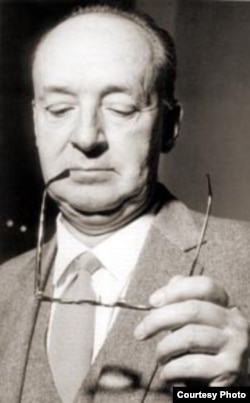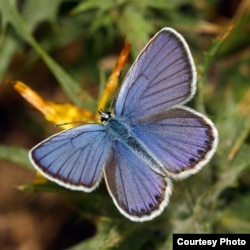"Pity Vladimir Vladimirovich is not here…He would have told us all about these enchanting insects."
The speaker of this line is Chateau, a character from the 1957 novel "Pnin," who is observing a "score of small butterflies," fluttering like "blue snowflakes."
The "Vladimir Vladimirovich" that the character thinks of is actually the book's author -- more familiarly known as Vladimir Nabokov.
But the famed Russian-American novelist doesn't let himself get away with the self-insertion entirely unscathed, as Pnin replies, "I've always had the impression that his entomology was merely a pose."
Throughout much of his life, when he wasn't writing, Nabokov was indeed a working lepidopterist, or butterfly expert, who turned a childhood fascination with the insects into earnest scientific study.
But today, these lines from "Pnin" ring with more irony than the author himself could likely have ever imagined.
'Uncannily Correct'
On January 25 in the journal "Proceedings of the Royal Society of London," a team of international scientists presented the results of a study into one of Nabokov's most adventurous ideas about butterflies – that a complex group of species known as Polyommatus blues had made five migrations from Asia, over the prehistoric Bering land bridge, and all the way down to South America, evolving in highly distinct ways over time.
Their conclusion? Nabokov was right.
"I truly did not expect that Vladimir Nabokov was so uncannily correct," says Roger Vila of the Institute of Evolutionary Biology in Barcelona, the lead researcher on the project. "There were alternative theories and much more recent [ones], made by modern taxonomists, so I was quite blown away to see that in 1945 he could see these relationships [between butterflies] and envision these trips in several waves in exact order and [that] everybody after him could not."
In his now famous 1945 paper, "Notes on Neotropical Plebejinae," the author first ventured his inference, based on his own comparative studies of male butterfly genitalia, that the blue creatures described in "Pnin" had migrated to the Americas in successive journeys.
While the author was curator of butterflies at Harvard's zoology museum and was known for descriptions of butterflies as meticulously detailed as his fiction, the theory generated little excitement in the scientific community.
Not Taken Seriously
The literary quality of his scientific writing, Vila says, may have led to his ideas being overlooked.
"The way he explained it, using such poetry -- I think this is the reason that it was not taken seriously by scientists," Vila says. "They thought it was not 'hard science,' let's say. I think this is the reason that this hypothesis has been waiting for such a long time for somebody to vindicate it."
But after nearly a decade of research, including expeditions to butterfly hotspots in the Andes and analyses of DNA and climate change, Vila's team found that flourishes aside, Nabokov's idea is supported by facts.
This isn't the first time that the author's butterfly work has defied skepticism.
'Magic Metamorphosis'
Brian Boyd, a Nabokov expert at the University of Auckland and co-editor of "Nabokov's Butterflies," says that he is occasionally asked to name new species of Polyommatus blues when they are found.
"There's a 'Lolita,' there's a 'Vera,' there's a 'Vokoban,' which is 'Nabokov' [spelled] backwards, and all sorts of things," Boyd says. "These scientists ask literary scholars like me to suggest names that might describe the kinds of characteristics of a butterfly or its relationship to other butterflies that have already been given Nabokov names."
Boyd has also written on the role of butterflies in Nabokov's writings, which appear as fleeting references in some of his prose, key images in others, and are entirely absent from works, like his 1955 classic "Lolita."
Nabokov "didn't like anything being used as a symbol," Boyd says, but notes that on a number of occasions butterflies were used in his work to embody one particular motif.
"It is interesting that [Nabokov] was very interested in the possibility of an afterlife. And for the Greeks and for a lot of other people, the idea of an Earth-bound or plant-bound grub turning into a winged creature is quite a magic metamorphosis," Boyd says.
"There are times when there is a connection between butterflies and the possibility of an afterlife [in Nabokov's work] -- in an early story called 'Christmas' and in the novel 'Pale Fire.'"
Boyd's favorite butterfly name that he has suggested to science is Hazelia, a tribute to Hazel, a character in "Pale Fire," who "almost comes back after her suicide in the form of a butterfly."
Vila says one particular Nabokov story -- the author's life story -- might even have encouraged him to formulate his butterfly migration theory.
"Funny that Nabokov himself made this trip from Russia to the New World, right?" Vila says. "So maybe he got the inspiration from his own story."
The speaker of this line is Chateau, a character from the 1957 novel "Pnin," who is observing a "score of small butterflies," fluttering like "blue snowflakes."
The "Vladimir Vladimirovich" that the character thinks of is actually the book's author -- more familiarly known as Vladimir Nabokov.
But the famed Russian-American novelist doesn't let himself get away with the self-insertion entirely unscathed, as Pnin replies, "I've always had the impression that his entomology was merely a pose."
Throughout much of his life, when he wasn't writing, Nabokov was indeed a working lepidopterist, or butterfly expert, who turned a childhood fascination with the insects into earnest scientific study.
But today, these lines from "Pnin" ring with more irony than the author himself could likely have ever imagined.
'Uncannily Correct'
On January 25 in the journal "Proceedings of the Royal Society of London," a team of international scientists presented the results of a study into one of Nabokov's most adventurous ideas about butterflies – that a complex group of species known as Polyommatus blues had made five migrations from Asia, over the prehistoric Bering land bridge, and all the way down to South America, evolving in highly distinct ways over time.
Their conclusion? Nabokov was right.
"I truly did not expect that Vladimir Nabokov was so uncannily correct," says Roger Vila of the Institute of Evolutionary Biology in Barcelona, the lead researcher on the project. "There were alternative theories and much more recent [ones], made by modern taxonomists, so I was quite blown away to see that in 1945 he could see these relationships [between butterflies] and envision these trips in several waves in exact order and [that] everybody after him could not."
In his now famous 1945 paper, "Notes on Neotropical Plebejinae," the author first ventured his inference, based on his own comparative studies of male butterfly genitalia, that the blue creatures described in "Pnin" had migrated to the Americas in successive journeys.
While the author was curator of butterflies at Harvard's zoology museum and was known for descriptions of butterflies as meticulously detailed as his fiction, the theory generated little excitement in the scientific community.
Not Taken Seriously
The literary quality of his scientific writing, Vila says, may have led to his ideas being overlooked.
"The way he explained it, using such poetry -- I think this is the reason that it was not taken seriously by scientists," Vila says. "They thought it was not 'hard science,' let's say. I think this is the reason that this hypothesis has been waiting for such a long time for somebody to vindicate it."
But after nearly a decade of research, including expeditions to butterfly hotspots in the Andes and analyses of DNA and climate change, Vila's team found that flourishes aside, Nabokov's idea is supported by facts.
This isn't the first time that the author's butterfly work has defied skepticism.
A male blue butterfly of the genus Lycaeides. According to new research, the ancestors of this species colonized the Americas through Asia some 2.4 million years ago. (photo by Vlad Dinca)
In 1918, a 19-year-old Nabokov reported finding a species of butterfly in Crimea. When researchers failed in successive years to capture another example of the species in the region, most presumed Nabokov had erred. It was not until 70 years later, in 1988, that Ukrainian butterfly expert Konstantin Efetov again found the species in area, proving Nabokov correct.'Magic Metamorphosis'
Brian Boyd, a Nabokov expert at the University of Auckland and co-editor of "Nabokov's Butterflies," says that he is occasionally asked to name new species of Polyommatus blues when they are found.
"There's a 'Lolita,' there's a 'Vera,' there's a 'Vokoban,' which is 'Nabokov' [spelled] backwards, and all sorts of things," Boyd says. "These scientists ask literary scholars like me to suggest names that might describe the kinds of characteristics of a butterfly or its relationship to other butterflies that have already been given Nabokov names."
Boyd has also written on the role of butterflies in Nabokov's writings, which appear as fleeting references in some of his prose, key images in others, and are entirely absent from works, like his 1955 classic "Lolita."
Nabokov "didn't like anything being used as a symbol," Boyd says, but notes that on a number of occasions butterflies were used in his work to embody one particular motif.
"It is interesting that [Nabokov] was very interested in the possibility of an afterlife. And for the Greeks and for a lot of other people, the idea of an Earth-bound or plant-bound grub turning into a winged creature is quite a magic metamorphosis," Boyd says.
"There are times when there is a connection between butterflies and the possibility of an afterlife [in Nabokov's work] -- in an early story called 'Christmas' and in the novel 'Pale Fire.'"
Boyd's favorite butterfly name that he has suggested to science is Hazelia, a tribute to Hazel, a character in "Pale Fire," who "almost comes back after her suicide in the form of a butterfly."
Vila says one particular Nabokov story -- the author's life story -- might even have encouraged him to formulate his butterfly migration theory.
"Funny that Nabokov himself made this trip from Russia to the New World, right?" Vila says. "So maybe he got the inspiration from his own story."












